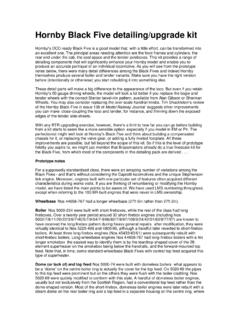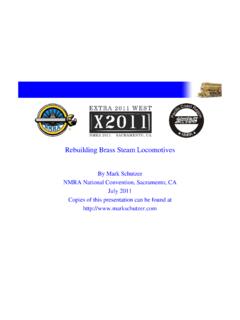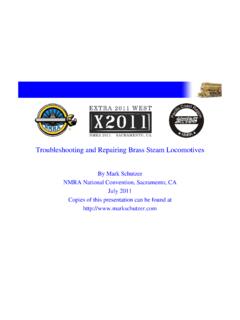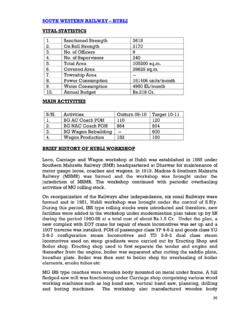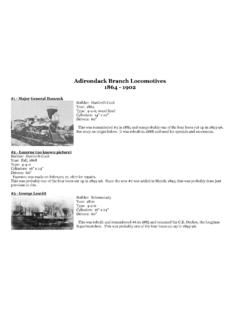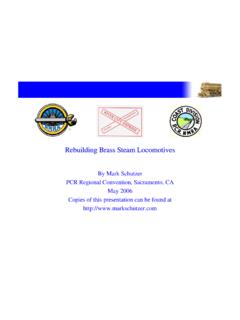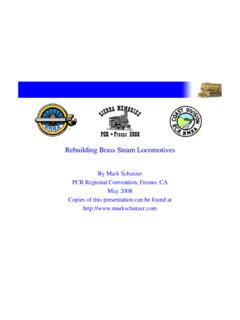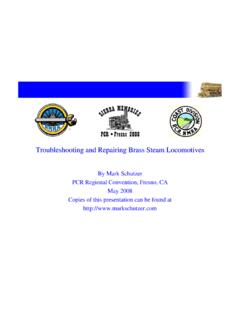Transcription of Brassmasters
1 Brassmasters Scale Models L&SWR/SOUTHERN RAILWAY ADAMS 0415 RADIAL 4-4-2T locomotive KIT Designed by Martin Finney 4MM SCALE OO - EM - P4 INSTRUCTIONS AND PROTOTYPE NOTES PO Box 1137 Sutton Coldfield B76 1FU Copyright Brassmasters 2017 1 SECTION 1: BRIEF HISTORICAL DETAILS The locomotives, which form the subject of this kit, were to the design of William Adams for the LSWR. They were a development of his 46 class of 1878. A total of 71 locomotives were built at by four outside builders as follows: Numbers Delivered Maker Tanks Blower valve Dome Trailing wheels Tank front 415-426 8/1882 10/1882 Beyer, Peacock Short left small 3 0 low 45/7-57,427-32 10/1883- 12/1883 & Co. Short left small 3 0 low 169-71/73,490-5 11/1884- 12/1884 Dubs & Co. Long right large 3 0 high 479-489 2/1885-3/1885 Neilson & Co. Long right large 3 0 low 516-525 11/1885-12/1885 Dubs & Co.
2 Long right large 3 6 high 68,77/8,82* 104/6/7/25/6/9 6/1885-10/1885 & Co. Long left small 3 6 high , 77/8 were renumbered 58-60 in 3/1889, 6/1890 and 8/1890. 125 and 520 became Southern Railway 3125 and 3520 in 11/1933 and 12/1934. After a chequered career, 488 was renumbered Southern Railway 3488 in 11/1946. At Nationalisation these three were renumbered again as follows: SR No. BR No. Date 3125 30582 3/1949 3488 30583 10/1949 3520 30584 4/1948 For a detailed history of this numerous class I suggest you refer to the following definitive books by the late : Part two of The Locomotives of the published by the LSWR Locomotives - The Adams Classes published by Wild Swan. Other valuable sources of information and photographs are: A Pictorial Record of Southern Locomotives - - OPC Locomotives Illustrated No.
3 59 LSWR Outside-cylinder Tank Locomotives - Ian Allan Southern steam locomotive Survey - The Adams Classes - Bradford Barton lots of prototype photographs With such a large number of locomotives, built by four different builders, and lasting in service for over 75 years, there are considerable variations between individual engines. Many of these I have attempted to cover by including alternative components in the kit, however it is essential to have a photograph of the individual locomotive you propose to construct to enable an authentic model to be built. Variations/Modifications incorporated into the kit Rivets: In traditional Beyer, Peacock style the first ten engines were built using snap head rivets. The remaining engines were all built using mainly flush rivets on the running plate and above. Tank length: The first 28 locomotives had very short side tanks.
4 Subsequent locomotives had longer tanks of increased capacity. 2 Blower valve: The position of the blower valve, as shown in the table, varied depending on the builder. Late survivors had the blower valve moved, in Drummond style, to the side of the smokebox with the operating rod inside the handrail, which was lengthened for the purpose. Dome: Domes were of two sizes as shown in the table. Trailing wheels: The last twenty engines had the trailing wheel diameter increased to 3 6 . Tank front: On some engines the top edge of the tank front was flush with the tank top. On others the front was extended to the same height as the tank sides with the beading carried round over the tank front. Chimney: When built the locomotives had Adams stove pipe chimneys. These were replaced by Drummond from February 1901 with his distinctive design. Slidebars: From circa 1907 numbers 47, 52, 57, 125, 129, 415, 419 and 520 were fitted with double slidebars.
5 Splashers: The splashers of the Beyer, Peacock engines were adorned with that maker s builders plates. The splashers of the other engines had a wide beading in a circular arc. Front frames: The Neilson & Co. engines had front frames to a profile different from the remainder. The frames of numbers 125 and 520 were replaced by the Southern Railway during an extensive rebuilding at Eastleigh during 1930. The new frames were to a new profile at the front. Cab cut-out: The Neilson & Co. engines had a different cab side cut out to the remainder. Boiler handrail: The position of the boiler handrail knobs depended on the builder. The boiler handrail on the Beyer, Peacock engines was attached with distinctive brackets. Tank lifting brackets: In SR days lifting brackets were fitted to the top of each tank. Coal rails: Three bunker coal rails were fitted from circa 1900.
6 Later still the coal rails were backed by metal sheeting to stop the loss of small coal. Cab rear windows: After the fitting of coal rails most engines were fitted with bars of either wood or metal over the rear cab windows. Some of the later survivors were subsequently fitted with smaller windows. Water filler: As the coal rail and rear window changes took place so the height of the water filler increased to allow more coal to be carried. Cab roof: The original cab roofs were wooden. From circa 1900 they were replaced, by Drummond, with steel roofs. Safety chains: When built the engines were fitted with safety chains. These were gradually removed during Drummond s time. steam heating: From circa 1901 carriage heating steam pipes were fitted. Lamp brackets: The locomotives were built with Adam's socket style brackets. Drummond added new brackets of his design over the buffers at the front and rear and above the coupling hook at the rear.
7 The SR standardised on a design with the socket in the lamp and the later survivors were gradually with new brackets of standard design. Smokeboxes: When smokeboxes were renewed by the Southern Railway, the flush riveting was often replaced by visible snap head rivets. Couplings: The engines in their early years ran with a single, long coupling link often with a separate screw coupling hanging from the draw hook. Later the locomotives were equipped with screw couplings together with a hook to carry the coupling when it was not required. Variations/Modifications not incorporated into the kit New Adams boilers: From1895 seven new boilers were built and fitted Nos. 57,170,483, 486,490,492 and 517. With these new boilers came new cabs with round lookout windows. Drummond boilers: In 1907 two new boilers of Drummond pattern with dome top safety valves were built and fitted initially to 486 and 520.
8 3 SECTION 2: CHASSIS DETAILS Note that many of the components for both chassis and body are handed left/right and care must be taken to ensure the correct component is used. I have not always identified left/right components separately but with care and common sense no problems should arise. It is also sensible to open up all holes to fit the appropriate component/wire, and to emboss all appropriate rivets before that component is fitted. Before construction can commence you have to decide which particular chassis you are going to construct. The options are: GAUGE - 00, EM or P4 SUSPENSION - rigid, sprung or compensated PICKUPS - no pickup material is provided. The options are: Scrapers attached to the frame stretchers using printed circuit board. Plunger. Open out the marked holes and fit according to the manufacturer s instructions.
9 Note, if you are building a compensated chassis then the holes for the front plungers must be lowered as shown in Fig. 1. Split axle/frame - I leave this to you! INSIDE VALVE GEAR - Whether you wish to fit the working inside valve gear. MOTOR - not provided - Portescap 1219 or High Level/Mashima recommended SECTION 3: FRAMES Having decided which chassis to construct you can now start construction by preparing the frames (parts F1 & F2). First open out the holes in the frames to the appropriate size and emboss all the frame rivets. Form the frame joggle to narrow the frames at the rear. Make the first bend inwards through 10 along the front half-etched line and strengthen the bend with a fillet of solder. Then make the second bend outwards in the same way. Fold in the radial truck hornguides. For a rigid chassis open out the main axle holes to accept 1/8" top hat bearings (not provided) and solder them in place.
10 If you are going to fit sprung horn blocks, you should remove the axle holes by cutting up the half-etched lines, leaving a standard 6mm wide slot and then follow the manufacturer s instructions. The simplest and most reliable suspension system is beam compensation and the necessary compensation beams, bearings and hornblocks are provided in the kit. For a compensated chassis first remove the axle holes as described above. Carefully widen the slots in the hornblocks (part 9) until the Flexichas bearings are a good fit. I find a significant variation in the bearings and once I have fitted a hornblock to a bearing, I mark the bearing and hornblock, so that they can be later assembled together. A good fit between hornblock and bearing is essential if the chassis is to run well. Solder one of the rear hornblocks to the inside of the frame aligning it with the half-etched lines and with the bottom of the frame.
